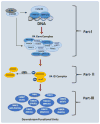Multifaceted Fanconi Anemia Signaling
- PMID: 29254745
- PMCID: PMC5858900
- DOI: 10.1016/j.tig.2017.11.006
Multifaceted Fanconi Anemia Signaling
Abstract
In 1927 Guido Fanconi described a hereditary condition presenting panmyelopathy accompanied by short stature and hyperpigmentation, now better known as Fanconi anemia (FA). With this discovery the genetic and molecular basis underlying FA has emerged as a field of great interest. FA signaling is crucial in the DNA damage response (DDR) to mediate the repair of damaged DNA. This has attracted a diverse range of investigators, especially those interested in aging and cancer. However, recent evidence suggests FA signaling also regulates functions outside the DDR, with implications for many other frontiers of research. We discuss here the characteristics of FA functions and expand upon current perspectives regarding the genetics of FA, indicating that FA plays a role in a myriad of molecular and cellular processes.
Keywords: DNA damage response; Fanconi anemia; aging; cancer; developmental defects; replication.
Copyright © 2017 Elsevier Ltd. All rights reserved.
Figures



References
Publication types
MeSH terms
Substances
Grants and funding
LinkOut - more resources
Full Text Sources
Other Literature Sources

